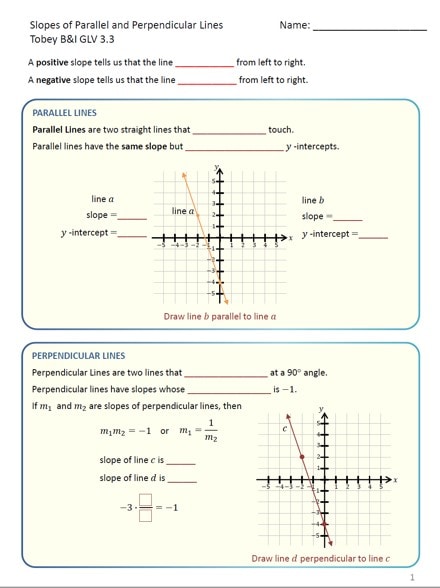
Guided Notes: Road Signs to Success for Video-Based Learning in Math Courses

We’ve all been there. We sit down to watch a movie. The storyline is a little slow in the beginning and our minds start to drift. As we try to bring our attention back to the screen, we decide we’re a little hungry. We get up and go to the kitchen to make a snack, all the while telling ourselves that we didn’t need to pause the movie because we can hear it in the kitchen. We return to the living room and settle-in to watch the movie as we munch on our pizza rolls and soda. The food rouses little Gizmo from underneath the couch and she sneaks out to investigate the enticing aroma. We offer her part of our snack and give her a little scratch behind the ears. Before we know it, we are involved in an all-out tug-of-war with a 10 pound ball of fur. The movie is long forgotten.
Now replace the movie in this scenario with the carefully constructed video lessons that you have created for your students so that they would be eager to delve into the latest lesson on solving equations or factoring polynomials. The truth is that most students endure video lectures as a means to an end but struggle to stay engaged enough to absorb the material. It would be easy to say that this is just an issue for developmental or freshmen level students. The harsh reality is that it is true at all levels in all subjects. I witnessed first-hand as my son, who was finishing a master’s degree in Biosystems Engineering, struggled to stay awake while watching online lectures for a required statistics course which was only offered in an online format. He would stop every ten minutes, literally take a lap around the house, and then sit down to try and watch a few more minutes.
While there is no universal solution to this difficulty for students, we can supply them with tools which will help to mitigate the time lost to distracted viewing. When I created full lesson videos for my online students several years ago (pre-covid), I included colorful guided notes to help them stay engaged with the material. Using PDF files deployed in our learning management system, I supply my students with word-for-word, picture-for-picture materials that match the video they are watching. I have strategically placed blanks and empty boxes on these guided pages, so that the student must fill-in-the-blank as they watch the video. If their mind begins to wander, they will miss a blank or box and will have to rewind to get the needed information. Sometimes the blanks are words that are being said in the audio. Sometimes the boxes are specific letters or numbers that are relative to the problem being shown. It is important to include three keys for creating and successfully implementing guided notes in your course: Color, Active Learning, and Grading.

Color: Many people dismiss the importance of using color to create interesting and engaging materials. But when a student sees an endless page of black and white text, they generally sigh heavily and begin mentally checking out. The reason that marketing companies fill our mailboxes with endless colorful fliers is because it captures our attention. I don’t believe that any of us really outgrow the enjoyment of the colorful worksheets that we used in elementary school. You may also use color to differentiate between “scenes” in the video lesson. A large colorful box with important text inside helps students to focus on just that smaller amount of material. This is not as overwhelming as an entire page of endless text.
Active Learning: Another important feature in your guided notes is an active learning lesson. After you present the lesson, be sure to include a problem or two that you didn’t do in the video. This gives the student the opportunity to immediately try what you have presented on their own. Be sure to include the answer on the guided notes, but don’t provide the step-by-step instructions for this problem. This serves two purposes. Watching a video is a more passive learning method. The guided notes help to create an active learning environment, and this final question helps to really move the student from passive “feed them every step” learning to actively working the problem on their own. It also gives you immediate insight into whether the student understood the material.
Grading: This brings us to our last key in successfully implementing guided notes. The notes must be used as part of their grade. If it is not for a grade, then they won’t use them. (And they need to use them!!!) I am very excited about the new Freehand Grader Assignments in MyLab Math that I can set up for my guided note worksheets. These types of assignments can now be put into MyLab rather than having students upload their guided notes to our learning management system. Keeping all their work in one place is very beneficial, especially for lower-level students, and grading guided notes provides an important incentive for students to use them. Guided notes are an appealing low-stakes assignment that can motivate a student to get started after a long day at work.
I hope that you will choose to create guided notes along with your lesson videos. Even though I originally created these colorful notes to help move my online students from passive learning to active learning, I now use them as graded assignments in my face-to-face courses as well. Since students often wait a day or two to begin their assignments, I have found that requiring the video lessons with guided notes assignments provides my students with a refresher over the material that was covered in class. It also means that a full lesson is available even if they must miss class. Most importantly, all these things have made a significant impact on the success of my students.
To learn more about Anne’s use of videos and guided notes for a variety of class formats, you can watch her previously recorded webinar here.
About the author

Anne A. Fischer
Anne is an Associate Professor of Mathematics and Developmental Studies at Tulsa Community College. As the director of the math tutoring lab, she found her love for helping mathematics students who lack a college-level skill set. Her goal each semester is to help her students to not ‘hate’ math and gain confidence in their ability to be successful in mathematics. She doesn’t ask them to love math, that’s too big a jump. As a member of the Tobey/Slater series author team, she has created over 250 full-lesson videos designed for online developmental math learners to move from passive learning to active learning. She holds both a Bachelor and Master of Science in Mathematics and is a Certified Developmental Education Specialist. When she is not teaching, she loves to spend time on the lake with her grandchildren.



